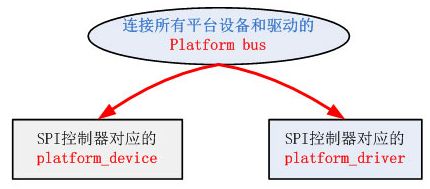platform机制
最近在看SPI、I2C这样简单点的总线驱动程 序,从Linux2.6起,内核引入了一套新的驱动管理和注册机制:Platform_device和Platform_driver。现在Linux中 大部分的设备驱动都可以使用这套机制,总线为platform_bus,设备用platform_device表示,驱动用 platform_driver进行注册。
Linux的这种platform driver机制和传统的device_driver机制相比,一个十分明显的优势在于platform机制将本身的资源注册进内核,由内核统一管理,在 驱动程序中使用这些资源时通过platform_device提供的标准接口进行申请并使用。这样提高了驱动和资源管理的独立性,并且拥有较好的可移植性 和安全性。下面是SPI驱动层次示意图,Linux中的SPI总线可理解为SPI控制器引出的总线:

和传统的驱动一样,platform机制也分为三个步骤:
1、总线注册阶段:
内核启动初始化时的main.c文件中的 kernel_init()→do_basic_setup()→driver_init()→platform_bus_init()→bus_register(&platform_bus_type), 注册了一条platform总线(虚拟总线,platform_bus)。
2、添加设备阶段:
设备注册的时候Platform_device_register()→platform_device_add()→(pdev→dev.bus = &platform_bus_type)→device_add(),就这样把设备给挂到虚拟的总线上。
3、驱动注册阶段:
Platform_driver_register()→driver_register()→bus_add_driver()→driver_attach()→bus_for_each_dev(), 对在每个挂在虚拟的platform bus的设备作__driver_attach()→driver_probe_device(),判断drv→bus→match()是否执行成功,此 时通过指针执行platform_match→strncmp(pdev→name , drv→name , BUS_ID_SIZE),如果相符就调用really_probe(实际就是执行相应设备的 platform_driver→probe(platform_device)。)开始真正的探测,如果probe成功,则绑定设备到该驱动。
从上面可以看出,platform机制最后还是调用了bus_register() , device_add() , driver_register()这三个关键的函数。
下面看几个结构体:
- struct platform_device (/include/linux/Platform_device.h)
- {
- const char * name;
- int id;
- struct device dev;
- u32 num_resources;
- struct resource * resource;
- };
Platform_device结构体描述了一个platform结构的设备,在其中包含了一般设备的结构体struct device dev;设备的资源结构体struct resource * resource;还有设备的名字const char * name。(注意,这个名字一定要和后面platform_driver.driver àname相同,原因会在后面说明。)
该结构体中最重要的就是resource结构,这也是之所以引入platform机制的原因。
- struct resource ( /include/linux/ioport.h)
- {
- resource_size_t start;
- resource_size_t end;
- const char *name;
- unsigned long flags;
- struct resource *parent, *sibling, *child;
- };
其中 flags位表示该资源的类型,start和end分别表示该资源的起始地址和结束地址(/include/linux/Platform_device.h):
- struct platform_driver
- {
- int (*probe)(struct platform_device *);
- int (*remove)(struct platform_device *);
- void (*shutdown)(struct platform_device *);
- int (*suspend)(struct platform_device *, pm_message_t state);
- int (*suspend_late)(struct platform_device *, pm_message_t state);
- int (*resume_early)(struct platform_device *);
- int (*resume)(struct platform_device *);
- struct device_driver driver;
- };
Platform_driver结构体描述了一个platform结构的驱动。其中除了一些函数指针外,还有一个一般驱动的device_driver结构。
名字要一致的原因:
上面说的驱动在注册的时候会调用函数bus_for_each_dev(), 对在每个挂在虚拟的platform bus的设备作__driver_attach()→driver_probe_device(),在此函数中会对dev和drv做初步的匹配,调用的是 drv->bus->match所指向的函数。platform_driver_register函数中 drv->driver.bus = &platform_bus_type,所以drv->bus->match就为platform_bus_type→match, 为platform_match函数,该函数如下:
- static int platform_match(struct device * dev, struct device_driver * drv)
- {
- struct platform_device *pdev = container_of(dev, struct platform_device, dev);
- return (strncmp(pdev->name, drv->name, BUS_ID_SIZE) == 0);
- }
是比较dev和drv的name,相同则会进入really_probe()函数,从而进入自己写的probe函数做进一步的匹配。所以dev→name和driver→drv→name在初始化时一定要填一样的。
不同类型的驱动,其match函数是不一样的,这个platform的驱动,比较的是dev和drv的名字,还记得usb类驱动里的match吗?它比较的是Product ID和Vendor ID。
个人总结Platform机制的好处:
1、提供platform_bus_type类型的总线,把那些不是总线型的soc设备都添加到这条虚拟总线上。使得,总线——设备——驱动的模式可以得到普及。
2、提供platform_device和 platform_driver类型的数据结构,将传统的device和driver数据结构嵌入其中,并且加入resource成员,以便于和Open Firmware这种动态传递设备资源的新型bootloader和kernel 接轨。
platform机制的更多相关文章
- 详解Linux2.6内核中基于platform机制的驱动模型 (经典)
[摘要]本文以Linux 2.6.25 内核为例,分析了基于platform总线的驱动模型.首先介绍了Platform总线的基本概念,接着介绍了platform device和platform dri ...
- linux设备驱动归纳总结(九):1.platform总线的设备和驱动【转】
本文转载自:http://blog.chinaunix.net/uid-25014876-id-111745.html linux设备驱动归纳总结(九):1.platform总线的设备和驱动 xxxx ...
- [platform]linux platform device/driver(二)--Platform Device和Platform_driver注册过程之详细代码
转自:http://www.cnblogs.com/haimeng2010/p/3582403.html 目录: 1.platform_device注册过程 2.platform_driver注册过程 ...
- Linux platform设备简介
Technorati 标签: Linux platform Linux在2.6内核中,针对一系列设备驱动,提供新的管理框架,成为platform机制,推出的目的,在于隔离驱动的资源和实现,使得 ...
- platform
作者yuanlulu httpblogcsdnnetyuanlulu版权没有但是转载请保留此段声明 第1章platform驱动管理机制 platform_device 数据结构 注册流程 platfo ...
- 驱动之路-platform简例按键驱动☆☆☆
一 .重要知识点: ▉1.platform设备模型 从Linux 2.6起引入了一套新的驱动管理和注册机制,platform_device和platform_driver,Linux中大部分的设备驱动 ...
- linux 内核驱动--Platform Device和Platform_driver注册过程
linux 内核驱动--Platform Device和Platform_driver注册过程 从 Linux 2.6 起引入了一套新的驱动管理和注册机制 :Platform_device 和 Pla ...
- 两年前实习时的文档——Platform学习总结
1 概述 驱动程序实际上是硬件与应用程序之间的中间层.在Linux操作系统中,设备驱动程序对各种不同的设备提供了一致的訪问接口,把设备映射成一个特殊的设备文件,用户程序能够像其它文件一样对设备文件进 ...
- 14.LINUX-platform机制实现驱动层分离(详解)
版权声明:本文为博主原创文章,未经博主允许不得转载. 本节目标: 学习platform机制,如何实现驱动层分离 1.先来看看我们之前分析输入子系统的分层概念,如下图所示: 如上图所示,分 ...
随机推荐
- sae-服务器php运行环境配置
config.yaml 语法- OPTION: ARG1 ARG2 ... - OPTION: if (CONDICTIONs) ACTION CONDITION可以是以下任意一种: 使用 == 和 ...
- laravel homestead
laravel homestead真是个好东西啊,折腾了很长时间,终于ok啦. 安装成功之后,在-目录下有个homstead,进入执行vagrant up clzdeMBP:Homestead clz ...
- rman全备份异机恢复
一.测试环境 [oracle@localhost ~]$ uname -a Linux localhost.localdomain -.el6.x86_64 # SMP Tue May :: EDT ...
- 【springmvc Request】 springmvc请求接收参数的几种方法
通过@PathVariabl注解获取路径中传递参数 转载请注明出处:springmvc请求接收参数的几种方法 代码下载地址:http://www.zuida@ima@com/share/1751862 ...
- 软件测试 -- Bug等级划分规范
1. Blocker级别——中断缺陷 客户端程序无响应,无法执行下一步操作. 2. Critical级别――临界缺陷,包括: 功能点缺失,客户端爆页. 3. Major级别——较严重缺陷,包括: 功能 ...
- Servlet的getContextPath(), getServletPath(), getRequestURI(), getRealPath("/")
假定web application 名称为news,你在浏览器中输入请求路径: http://localhost:8080/news/main/list.jsp 则执行下面向行代码后打印出如下结果: ...
- 映像备份与恢复管理工具Easy Image X使用说明
Easy Image X(简称EIX)是一个支持Ghost映像(.gho)和ImageX映像(.wim)的映像管理工具,具有友好的图形界面,仅需几步简单操作即可完成映像备份与恢复工作.维护时使用最多的 ...
- Java之向左添加零(000001)第二种方法
//待测试数据 int i = 100; //得到一个NumberFormat的实例 NumberFormat nf = NumberFormat.getInstance(); //设置是否使用分组 ...
- ThinkPHP中视图模型详解.
很多TP的新手对于模型中的视图模型不甚了解,官方虽然有详细手册,但是对于初学者来说还是比较难以理解! 先简单说一下视图模型所能实现的功能,基本就是主表与副表之间各个字段的关联问题,实现多表关联查询,相 ...
- ASP.NET MVC 入门介绍 (上)
MVC模式 MVC模式是一种软件架构模式.它把软件系统分为三个部分:模型(Model),视图(View)和控制器(Controller).MVC模式最早由Trygve Reenskaug在1974年提 ...
